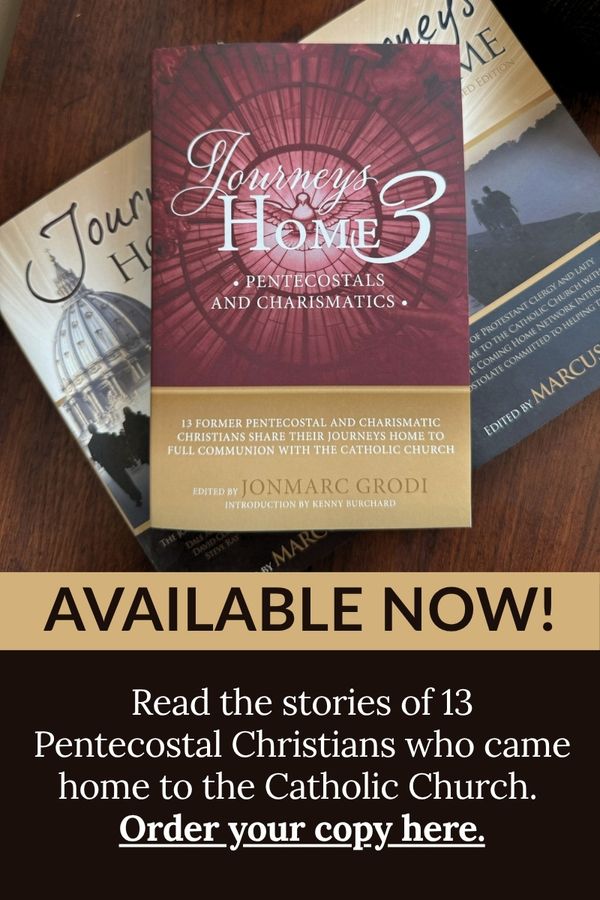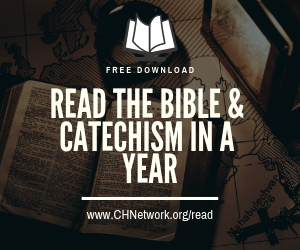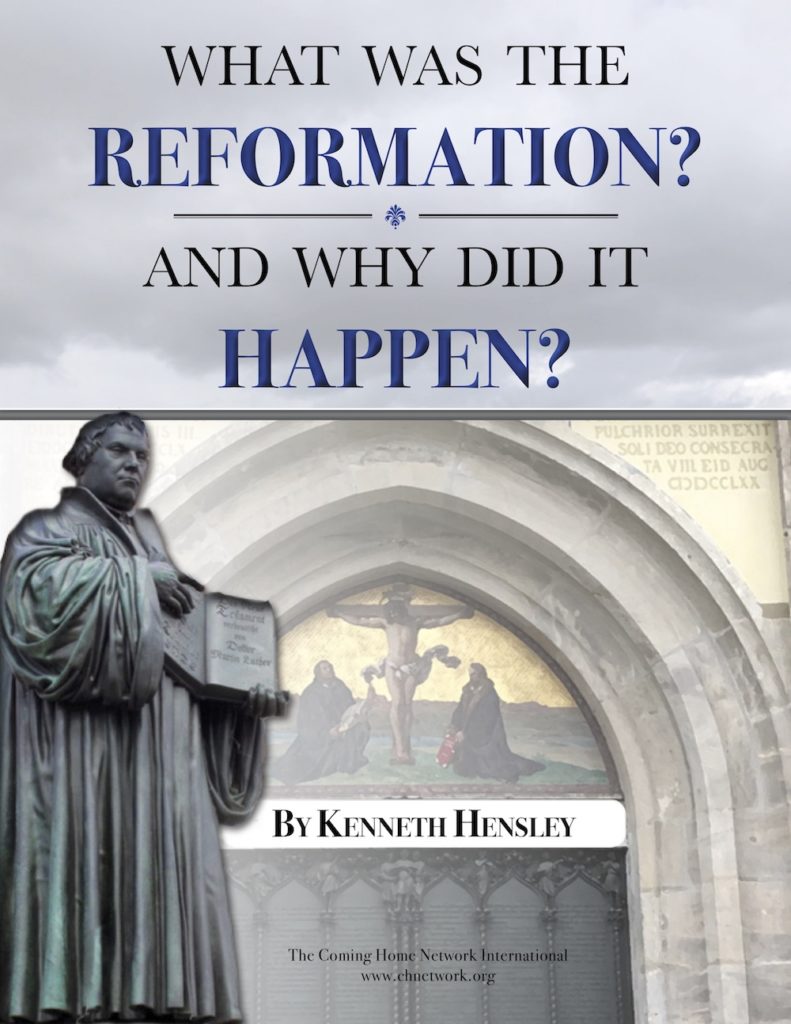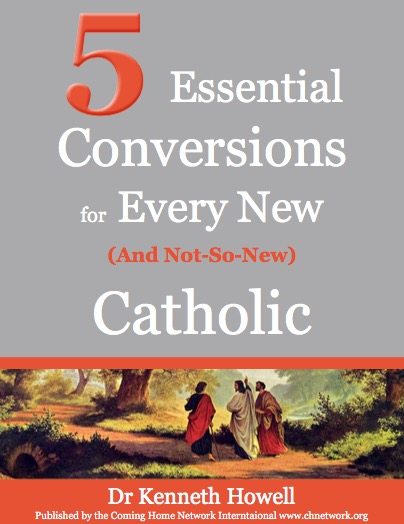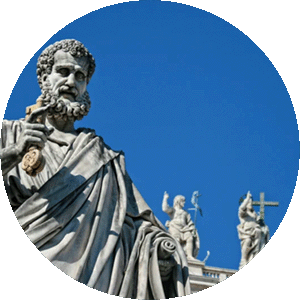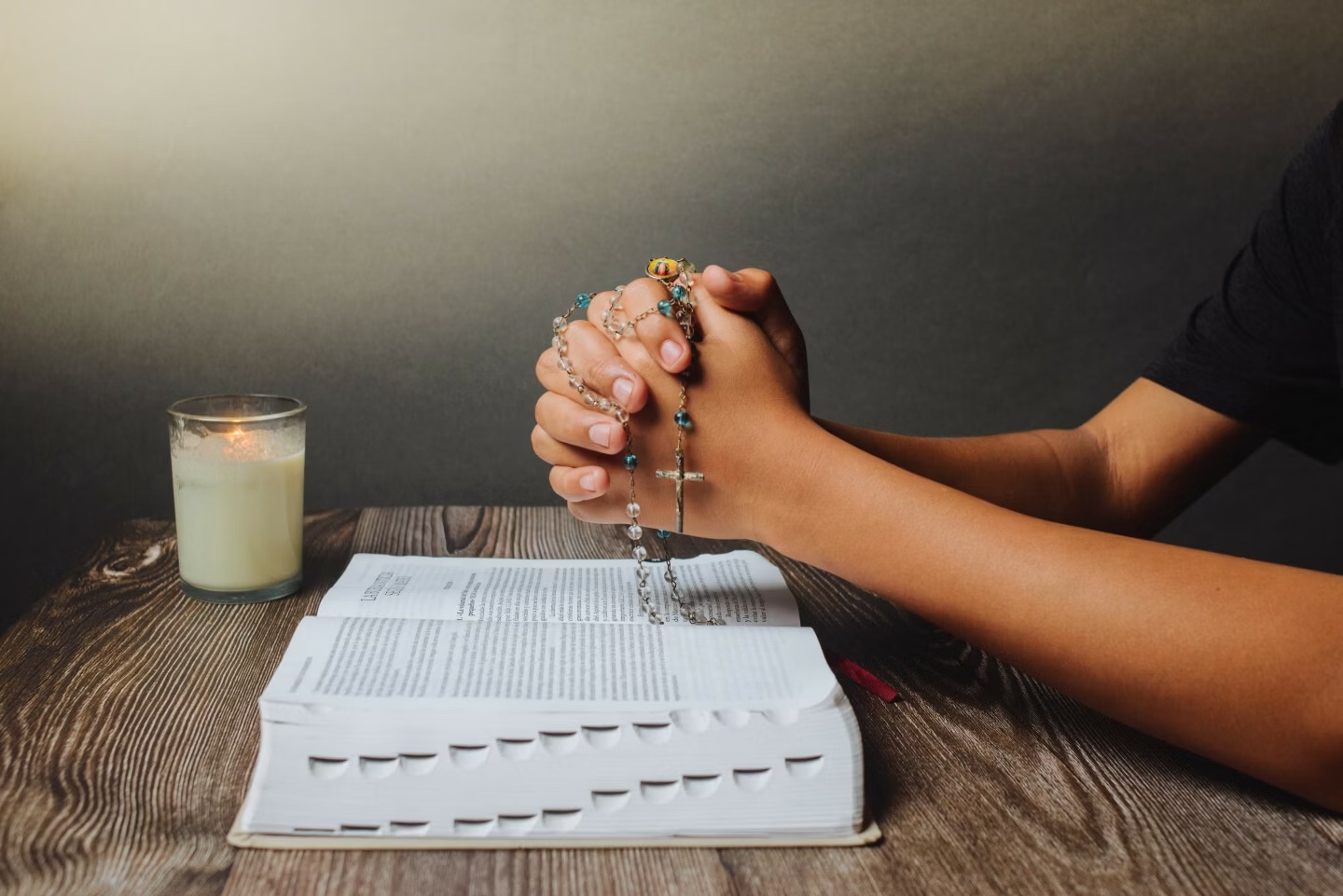
My wife’s tone of voice made it obvious; she was about to tell me something hard to hear: “I can’t be Protestant anymore, Joshua.”
I tried my best to remain calm, but this felt like one more challenge added to a difficult few years. It was early 2022, approximately 18 months since my wife, Chelsie, got COVID-19. As a result, she developed “Long COVID” and hadn’t been the same since. The hardest times for her were the nights.
In the midst of those lonely nights, Chelsie’s anxiety and pain made it challenging to pray, so she combed the internet for prayers she could listen to instead. She felt the most encouraged by the podcast Sing the Hours, a sung version of the Catholic Liturgy of the Hours. I was open to these sung prayers as well. I found them beautiful, even if the Marian hymns at the end were a bit off-putting. We were devout Christians and convinced Protestants, but we also prided ourselves on our ecumenism, finding beauty in all the varied bodies that made up God’s church. Cheslie couldn’t understand, though, why similar prayers from Protestant traditions brought her little solace. This was where the door cracked open, perhaps, but our story began long before.
The Early Years
Chelsie and I met at Berry College in Rome, Georgia. We never really had a “first date.” Instead, we casually spent an increasing amount of time with each other, until it became clear we were actually dating. I was attracted to her intelligence and sense of humor. We married shortly after we graduated in 2009, then moved to Austin, TX, where I began my graduate work in chemistry at the University of Texas. At the time, we were both professed Christians, but we weren’t especially committed to our faith. We didn’t attend church in Austin for the first few years and generally lived however we pleased. During this time, my life of sin caught up with me. In 2012, we welcomed our oldest daughter, Lillian. I felt convicted for the first time, after a particularly grievous sin, that I really was not a good person, and that my wife and daughter deserved better. So it was that, on Holy Saturday 2012, I repented of my sins and recommitted to a relationship with God. At Easter, I felt overjoyed by God’s grace. I did not need to be defined by my mistakes. Over the next decade, my wife and I both matured in the faith as we moved between a number of different Baptist and Non-denominational churches. After graduating with my PhD in chemistry, we moved to Atlanta, GA, to be near family.
In 2018, we joined the launch team of a multi-ethnic Non-denominational church being planted in Duluth, GA. My wife and I served as the directors of the childrens’ ministry, while I also occasionally preached on Sundays. The church was remarkable; it combined what we considered the best from the “liberal” and “conservative” traditions within Protestantism. It was deeply grounded in the Scriptures, with a theology steeped in grace, while also insisting we take social justice seriously. We were to pursue justice and mercy. We were taught to read all Scripture in light of the gospel, to consider all sin in light of God’s grace, and to pursue all righteousness by the power of Jesus’s cross. Most of my friends were from this church; the last thing I wanted was to leave these friends and the congregation that I loved.
Due to Chelsie’s illness, though, she had already ceased attending church, but still produced the childrens’ curriculum from home. Through our church’s teaching, we became convinced of the need to learn from Christians who came from a diverse range of backgrounds. This openness to diversity made us readily interested in learning from Christians throughout history, and so Chelsie read The Way of the Pilgrim, a famous story of an Orthodox peasant who wanders around Russia praying the Jesus Prayer (“Lord Jesus Christ have mercy on me”). This sparked her interest in the Orthodox faith and led her to read more about this tradition.
She began to feel that sola Scriptura was impossible, that Tradition played a central role in our faith even if we didn’t admit it, and that, ultimately, Scripture was a beautifully crafted and inspired story of redemption which drew us into the life of God, not a systematic theology textbook or a book of church order. Scripture answered many questions central to our faith, but left many others open to a variety of interpretations. For example, should we baptize infants or only adults? How should we organize church government? Who can administer communion? How exactly should we understand the relationship between the Father, Son, and the Holy Spirit? Is Christ present in the Eucharist? Is the Church a visible entity? Which texts should be considered canonical?
Christians have wrestled with these questions for centuries. They gathered church leaders from far and wide, coming to a surprising level of agreement, remaining unified for hundreds of years. Then, over a thousand years later, we were told to follow a different set of Christians and their new answers to these questions. To my wife, it seemed that Tradition had been smuggled into the whole system, even if each Protestant claimed their answers to these questions were guided by proper exegesis. Should we not follow instead those who plainly acknowledged their allegiance to both Scripture and Tradition?
I agreed that sola Scriptura was untenable if it meant we had no authority besides Scripture. We plainly must add reason (how else can you do exegesis?) and a respect for historic Christianity. Scripture was simply our final authority, before which all others must bow. But I also insisted that it wasn’t shocking to find a diversity of opinions on important questions. This was true in all human endeavors, not just religion. Finding ourselves with less information than we’d like, we all had to seek the truth as best we could.
Chelsie’s prior announcement then took a surprising turn—she insisted she wouldn’t leave the Protestant faith without me. If she was willing to remain in our shared tradition for the sake of unity, then I felt I owed her an honest inquiry. “I will give these questions a serious look,” I told her. While planning to do so genuinely, I also expected to return telling her that Protestants were right all along.
Dreams, Mass, and the Eucharist
This wasn’t the first time we had questioned our Reformation heritage. A year earlier, in the midst of our church’s emphasis on social justice, I had dreamt of the apocalypse. In my dream, I stood in a crowd of people, confused, debating how to best survive the end of the world. I looked away from the crowd and saw a narrow path between two chain link fences. A soldier helped those fleeing the coming calamity as they hurried down the path to safety. At that moment in my dream, I understood this narrow path was the Catholic Church.
The next day, I reached out to my older brother, who was Catholic. We had grown up in a family with six siblings, born to devout Protestant parents, to whom we owe our heritage: our baptism, our view of family as a deep good, our hope in a faith that could be integrated into our lives experientially and intellectually. My brother had converted to Catholicism during his time in Law School at Notre Dame. I expressed to him my interest in going to Mass, and we set a date in the near future.
The Mass we attended took place in the midst of the COVID-19 pandemic, and I had not been to an in-person service for months. I was moved by the liturgy, bored by the homily, and brought to tears by the Eucharist. I walked forward to receive a blessing from the priest and returned to my pew and knelt. Behind my face mask, I quietly wept, hoping no one would notice. The emotions I felt were familiar to me, but complicated. It is always this way when I simultaneously experience the lowly nature of humanity and the exalted nature of Christ, when I see my sins plainly before Christ’s sacrifice. I saw this same contrast now in the Eucharist; the Body and Blood of Christ reverenced with the greatest of care, yet chewed on like common food.
Later that week, I had another dream. This time I wept because I couldn’t receive the Eucharist. When I shared all of this with my wife, she was alarmed. A Catholic? They seem suspiciously Roman don’t they? And what about all of that business about Mary? Didn’t they decide only recently that she was assumed into heaven? Isn’t she considered the Queen of Heaven? How could we associate with such an organization?
Despite her alarm, she faithfully reached out to a local RCIA director to ensure I wouldn’t avoid this potential calling. One night around this time, however, I turned on the local Catholic radio station and heard a group of people droning in unison, “Hail Mary, full of grace, the Lord is with thee.…” Sure, I thought, they claim they don’t worship Mary, but that sure sounded like worship to me. Besides, I didn’t make decisions based on dreams and spiritual experiences. Instead, I based my worldview on reason and argument, and here the argument was plain: the Catholic Church promotes an idolatrous worship of Mary, thus the emotional appeal of the Church must be ignored. Chelsie told the RCIA director I was no longer interested.
Reading Scripture with the Early Church
Only a year later, my wife’s announcement brought these old questions back to the surface. How should I investigate her claims that Tradition was unavoidable and undermined sola Scriptura? From the outset, I was persuaded that sola Scriptura was a practical doctrine. Yet, to Christians in the ancient Church, such a doctrine would make little sense—the words of Peter or Paul were trustworthy, no matter how they were delivered. Thus Paul tells the church at Thessalonica: “So then, brethren, stand firm and hold to the traditions which you were taught by us, either by word of mouth or by letter” (2 Thessalonians 2:15).
The problem, of course, was that we had no access to the spoken teachings of the apostles at this point. Were we really to trust a game of telephone that’s been going on for 2,000 years? In my mind, it was exactly this game of telephone that led to the accumulation of so many false trappings in the Catholic and Orthodox traditions. It was for this reason that the Reformation was a much needed movement back to simplicity. I assumed the Reformers had stripped away from the faith everything wrongly accumulated through age, corruption, and human machinations.
The Scriptures, so my reasoning went, were the only access we had to those beliefs of the early Church that hadn’t been corrupted. As I began my investigation, though, I discovered this wasn’t true. We had access to early Christian writers whose lifespans overlapped with the Apostles and who lived in the communities they had established. Surely these writings would provide an important guide for reading and interpreting Scripture consistently with all the Apostles had passed on “by word of mouth or by letter” (2 Thessalonians 2:15). Wouldn’t we be better off reading Scripture through the lens of the early Church’s beliefs? Imagine if C.S. Lewis had lived in ancient Rome and knew the Apostles—wouldn’t we pay even closer attention to what he said?
Apostolic Succession and The Real Presence of Christ
I began with the earliest of these texts, the Epistle of Clement, written in the late first century while the Apostle John still lived. Clement, the Bishop of Rome, wrote to the church at Corinth about a recent controversy. It seems the Corinthians had recently thrown out their leaders and replaced them with ones more to their liking. Clement argued that, just as Moses established an ongoing priesthood in the Levites, so too, Christ has established an ongoing ministry through the Bishops.
Still, from my point of view, Clement wasn’t an infallible guide, so I returned to Scripture, my final authority. Read in light of Clement’s letter, hints at apostolic succession showed up all over the place. Throughout Acts and the Epistles, the Apostles pass on their authority through the laying on of hands and make clear they expect these leaders to do the same. Paul tells Titus, “This is why I left you in Crete, that you might amend what was defective, and appoint elders in every town as I directed you” (Titus 1:5). Was it not plain, then, that Paul was over Titus, and Titus over the elders he appointed? How clear was it, then, that a person in Crete, without a connection to an Apostle, could not just appoint himself as a leader of a new Christian community?
My low-church Protestant worldview was starting to feel less secure. It’s easy now to write without anxiety, but at the time, my stress level was growing daily. After a night of reading First Clement, I knelt beside my bed and asked God to give me clarity. “Give me a dream which points me to the truth,” I asked. That night, I tossed and turned as if in a fever dream with only one image before me — a set of four books bound as if one. I heard, “Pray with the four books of the Catholics.” Upon waking, I thought, “What an odd dream! Do Catholics even pray with four books?” I turned to Google: “What books do Catholics pray with?” No results. When I shared my quandary with my wife, she looked at me, as if to say, “Seriously!?”, and then said: “The breviary is four volumes.” I googled “How many volumes are in the breviary?” Google’s top line summary read, “Modern breviaries are nearly always printed in four volumes.” I began to pray these prayers each morning.
After Clement, I turned to the letters of Ignatius of Antioch. He served as the Bishop of Antioch and was martyred sometime in the early to mid-100s. On his way to Rome to face his death, he wrote a series of letters to various churches as he passed by them. His emphasis on church leadership was as strong as Clement’s, but he also pointed to a view of communion unfamiliar to me. As Ignatius headed off to die, he pleaded with the Roman Church not to prevent him from attaining martyrdom. He adds:
“I have no taste for corruptible food nor for the pleasures of this life. I desire the bread of God, which is the flesh of Jesus Christ, who was of the seed of David; and for drink I desire his blood, which is love incorruptible” (Ignatius’s Epistle to the Romans, 7).
This wasn’t a one-off mention of the Real Presence of Christ in the Eucharist. It was found throughout the writings of the early Church. For example, another early Christian writer, Justin Martyr, wrote to the Roman government, pleading with them to stop the persecution of Christians. In his letter, he described at length early Christian worship. About the Eucharist he said:
“We have been taught that the food which is blessed by the prayer of His word, and from which our blood and flesh by transmutation are nourished, is the flesh and blood of that Jesus who was made flesh” (First Apology, 66).
It was in the midst of these investigations that I attended a meeting to determine just how communion should be served in my Protestant church. At the meeting, we read from 1 Corinthians 11, where Paul gives instructions on communion. As we read, verses I had scarcely noticed before were highlighted in my mind: “Whoever, therefore, eats the bread or drinks the cup of the Lord in an unworthy manner will be guilty of profaning the body and blood of the Lord” (1 Corinthians 11:27). This didn’t sound like a memorial meal. And then: “For any one who eats and drinks without discerning the body eats and drinks judgment upon himself” (1 Corinthians 11:29; emphasis added). Just as in the case of apostolic succession, verses hinting at the Real Presence of Christ were easy to find when Scripture was read in light of the early Church’s beliefs.
Finally, as my beloved church decided how we ought to practice communion based on this text, one last line at the end of the chapter stood out to me: “About the other things I will give directions when I come” (1 Corinthians 11:34). Chelsie was right, I had to admit. The Apostles never intended us to guide our church life by Scripture alone; they left us with more.
The Real Presence of Christ and apostolic succession became linked together in my mind. Could just anyone pray the prayer that “by transmutation” brings forth the body of Christ from bread? Christ claims, “I am the living bread which came down from heaven; if any one eats of this bread, he will live for ever; and the bread which I shall give for the life of the world is my flesh” (John 6:51). Has this bread ever passed through my lips? What wouldn’t I sacrifice for this spiritual food?
Mother of the Church
In search of this divine food, I went looking through the history of schisms in the early Church. Christians remained united until the mid-400s, when the Church of the East and the Oriental Orthodox Churches split off over disputes about Christ’s nature. In the 1000s, the Eastern Orthodox Churches and the Catholic Church split over disputes on the nature of the Holy Spirit and the role of the pope. Each of these churches has unbroken lines of Apostolic Succession back to the great Church, and each church maintains the importance of this succession.
As I began to read about these ancient churches, I was struck by their commonalities. All of them believed that baptism actually forgives our sins and is essential for salvation. All of them affirmed the Real Presence of Christ in communion. All of them practiced the Sacrament of Penance (Confession). All of them venerated the saints, including Mary. All of them had an episcopal form of government. All of them believed the Church should be guided by Scripture and Tradition. In all these ways, they seemed to be more similar to the early Church than to Protestants. If Tradition had led them down such similar paths, perhaps the game of telephone was more reliable than I thought. I began to sense it was very unlikely that the 16th century Reformers should be trusted over such a great cloud of witnesses.
There were, of course, differences as well. How the Real Presence was articulated varied. How they thought of Mary’s exalted status varied, and, most importantly, their view of the bishop of Rome, the pope, varied.
At this point, our spiritual experiences were strongly pointing to the Catholic Faith. But would these experiences align with reason and a plausible view of history? Like the views of the Trinity, the canon, and the nature of Christ, the role of the pope took time to be solidified. In all these cases, trails of hints from the beginning became clarified over time. By the Second Ecumenical Council, in 381, Roman primacy was affirmed in passing as a part of another ruling.
Holy Mary, Mother of God
As I mentioned earlier, I had given up my previous interest in the Catholic Church after hearing their veneration of Mary on a local radio program. Now, I followed my standard protocol: learn about the beliefs of the early Church, then reexamine the texts of Scripture. In this case, Mary was revered from the earliest days of the Church. Irenaeus, a second century bishop, considered her the “new Eve,” the mother of the new creation. The earliest Marian hymn we have dates to the mid-200s and reads:
“Beneath thy compassion, we take refuge, O Theotokos (God-bearer): do not despise our petitions in time of trouble: but rescue us from dangers, only pure one, only blessed one.”
Returning to Scripture, Mary was portrayed as the heroine who accepts God’s demands to take on a child not fathered by her husband (Luke 1). This victory is highlighted through Zechariah’s failure to accept a message with far fewer personal difficulties. Elizabeth stands in the Old Covenant, elderly and barren despite persistent natural relations. Mary turns this pattern on its head — young and with child despite never knowing a man. Mary is said to be “full of grace” and called blessed four times in this chapter. She prophesies that this title will be recalled through all generations. As far as I could tell, I was the one living outside of the guideposts of Scripture, not the Catholics on the radio, venerating Mary.
Heading Home
Even after these investigations, I still wasn’t sure I fully agreed with Chelsie. I thought it might be possible to articulate sola Scriptura in a way that was coherent, provided we set Scripture as our final — but not only — authority. However, her insight about Tradition was exactly correct. For many questions, the data of Scripture left us with many seemingly plausible interpretations. The question then became, which framework ought we to prefer? The pride of place should be given to those who knew the Apostles and lived among them. We ought to let them tell us how to understand open questions in Scripture. Wasn’t this what we Protestants did when faced with the arguments of non-Nicene groups like Jehovah’s Witnesses or Oneness Pentecostals, who don’t believe in the Trinity? They had proof texts and could make arguments from Scripture, just like us. We didn’t typically line up the number of texts in each column and reassess our belief in the Trinity. Instead, we knew that to reject the Trinity was to reject the view of Scripture that was the consensus of the early Church. We needed to trust this consensus more often.
Throughout this entire journey, my wife and I had continually processed all of these things together: the writings of the early Church, our dreams, our visions, and our views of sola Scriptura. These all pointed in one direction: the Catholic Church. With a heavy heart, I told our pastor that we would soon be leaving his congregation to begin attending the local Catholic parish. We were sad to leave, but happy to head towards our true home. Through dreams, visions, and arguments, we had landed in the Catholic Church, but we still had much to learn of daily Catholic life. Through RCIA, we grew in our practical knowledge of the faith. We came to love the Theology of the Body; I learned from the Holy Family what it meant to be a father and a son; we came to realize the centrality of the Sacraments and longed to experience the fullness of the faith. After a year of inquiry and many years of nudging, we were ready to enter the Church.
On the Saturday after Easter in 2023, I knelt beside my chronically ill wife before the altar where Christ’s sacrifice is offered, and received the Body, Blood, Soul and Divinity of our Savior and Lord. One week later, my sweet daughters, Lillian and Sarah, joined us, partaking of the same Sacrament. The Catholic Church is everything our Protestant Christianity always was, but more.
The hardest thing to convey about joining the Church is the palpable experience of Christ’s power in our lives. I love attending Mass, and I love going to Confession. In them both, I experience a tangible conduit of God’s power in my life, filled with visible signs of invisible realities. God delights to work through His material creation to show us His mercy. I look forward to each day of my life in the Church, to attending Mass each day in retirement, and to dying in the bosom of the Church.

